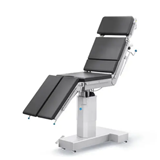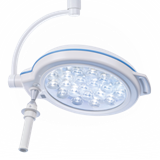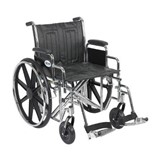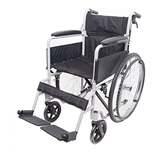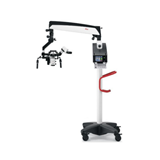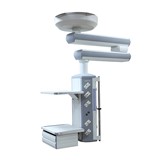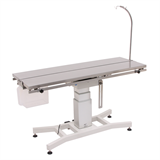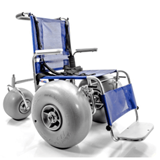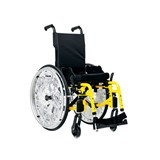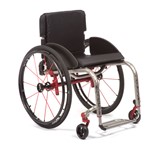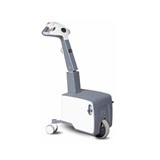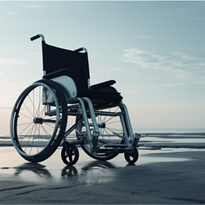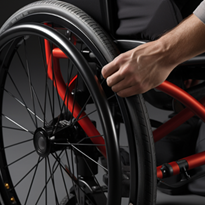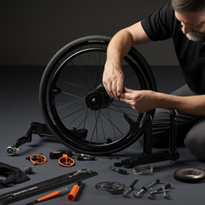Using a manual wheelchair can provide individuals with mobility challenges the freedom to move around independently. Whether you are a wheelchair user yourself or assisting someone who uses a manual wheelchair, mastering proper techniques and employing helpful tips is essential for a smooth and efficient experience. In this article, we explore the techniques and tips for operating a manual wheelchair comfortably and confidently.
-
Proper Seating Position:
- Position yourself comfortably in the wheelchair, ensuring that your back is well-supported against the backrest.
- Keep your feet flat on the footrests or footplates to maintain stability and prevent them from dragging on the ground.
- Adjust the seat height if possible, so your knees are at a 90-degree angle when your feet are on the footrests, promoting good posture.
-
Pushing and Braking:
- To move forward, place your hands on the wheelchair rims (the outer circular portions of the rear wheels) and push them forward.
- Use a firm grip and push in a rhythmic motion to maintain momentum.
- For braking, push the rims backward while applying gentle pressure to slow down or stop the wheelchair.
-
Turning:
- To make a sharp turn, push only one wheel forward while holding the other stationary. This technique is known as a one-wheel turn.
- For a smoother turn, apply even pressure to both rims, causing the wheels to move at different speeds.
-
Navigating Obstacles:
- When encountering obstacles like curbs or small steps, approach them at a perpendicular angle to reduce the impact.
- Place your hands on the handrims and apply a bit more force to propel the wheelchair over the obstacle.
-
Descending Slopes:
- When descending a slope, keep your hands on the handrims for control.
- Apply steady pressure on the rims to control your speed, and use the wheelchair's brakes if necessary to slow down further.
-
Ascending Slopes:
- Lean slightly forward when ascending a slope to maintain balance and prevent tipping backward.
- Grip the handrims firmly, and push the wheels forward with steady pressure to move uphill.
-
Pushing Techniques for Assistants:
- If you are assisting someone in a manual wheelchair, position yourself behind the wheelchair handles.
- Use a firm grip on the handles and walk at a comfortable pace while pushing.
-
Avoiding Overexertion:
- Take breaks as needed to prevent overexertion, especially during long distances or uphill journeys.
- Avoid rough or uneven terrain if possible, as it can be physically demanding.
-
Maintenance and Care:
- Regularly check the wheelchair's tires, brakes, and other components for wear and tear.
- Keep the wheelchair clean and lubricate moving parts to ensure smooth operation.
-
Choosing the Right Wheelchair:
- Select a wheelchair that suits your specific needs and lifestyle.
- Consider factors such as seat width, cushioning, and weight capacity for optimal comfort and safety.
Proper Seating and Posture Alignment in a Manual Wheelchair
Maintaining proper seating and posture alignment in a manual wheelchair is crucial for comfort, stability, and overall well-being. A well-fitted wheelchair and correct positioning can prevent discomfort, pressure sores, and other potential health issues. In this article, we explore the importance of proper seating and posture alignment in a manual wheelchair and provide tips on achieving optimal positioning.
1. Wheelchair Assessment and Fitting:
- Begin with a professional wheelchair assessment by a healthcare provider or a certified wheelchair specialist. They will consider factors such as body measurements, physical condition, and lifestyle to recommend an appropriate wheelchair model.
- Ensure the wheelchair's seat width and depth match the user's measurements to prevent pressure points and discomfort.
2. Proper Seat Height:
- Adjust the seat height to allow the user's feet to rest flat on the footrests or footplates. The knees should be at a 90-degree angle or slightly higher when the feet are on the footrests.
- Proper seat height prevents the user's feet from dragging on the ground and supports good posture.
3. Backrest Positioning:
- Position the backrest to support the natural curve of the user's spine. The lumbar area should receive adequate support to prevent slouching or excessive arching.
- If the wheelchair's backrest does not provide sufficient support, consider using additional lumbar cushions or back supports.
4. Proper Seat Depth:
- Ensure the wheelchair's seat depth is appropriate for the user's leg length. The user's hips should rest against the back of the seat, leaving a small gap between the knees and the edge of the seat.
- An excessively deep seat can cause pressure on the back of the knees, while a shallow seat may lead to inadequate support.
5. Armrest Positioning:
- Adjust the armrests so that the user's shoulders are relaxed when their arms rest comfortably on the armrests.
- Armrests that are too high can cause shoulder tension, while armrests that are too low can lead to slouching.
6. Head and Neck Support:
- If the user requires head and neck support, ensure the wheelchair is equipped with a headrest that can be adjusted to the desired height and angle.
- Proper head and neck support can prevent discomfort and enhance overall comfort during prolonged use.
7. Pelvic Positioning:
- Position the user's pelvis at the back of the wheelchair seat, ensuring even weight distribution.
- Use pelvic positioning belts or pads if needed to maintain pelvic stability.
8. Weight Distribution:
- Encourage the user to shift their weight periodically to relieve pressure on specific areas.
- Performing weight shifts every 15 to 30 minutes can help prevent pressure sores and improve circulation.
9. Regular Postural Checks:
- Perform regular postural checks to ensure the user maintains proper alignment and positioning throughout wheelchair use.
- Make adjustments as necessary to maintain optimal posture.
10. Repositioning and Movement:
- Encourage the user to reposition themselves and change their sitting position periodically.
- Encouraging movement can prevent stiffness and promote blood circulation.
Pushing and Propelling Techniques for Efficient Mobility
Efficient mobility is a key goal for individuals using manual wheelchairs, and mastering proper pushing and propelling techniques is essential for achieving this objective. By employing the right techniques, users can maximize their mobility, reduce fatigue, and enhance overall comfort while moving around. In this article, we will explore the important pushing and propelling techniques for efficient mobility in a manual wheelchair, helping users navigate their surroundings with greater ease and effectiveness.
1. Pushing with Proper Posture
Maintaining proper posture while pushing the wheelchair is vital for both efficiency and preventing strain or injuries. Here are some tips for pushing with proper posture:
- Sit Upright: Ensure you are sitting upright with your back against the backrest. Avoid slouching, as it can lead to unnecessary strain on your back and shoulders.
- Position Hands Correctly: Place your hands on the push rims, keeping them at shoulder-width apart. Your elbows should be slightly bent to allow for comfortable and efficient pushing.
- Use Smooth and Controlled Movements: Avoid sudden jerky movements while pushing the wheelchair. Instead, use smooth and controlled strokes to maintain a steady pace.
2. Grip and Push Rim Technique
A proper grip on the push rims is crucial for effective propulsion. Follow these guidelines for a secure grip and effective push rim technique:
- Thumb Placement: Position your thumbs on top of the push rim to help guide the wheelchair's direction and maintain control.
- Hand Placement: Place the rest of your fingers underneath the push rim for optimal leverage and power during propulsion.
- Push and Release: Push the push rims forward with your hands, then release the pressure slightly before your hands reach the bottom. This push-and-release technique allows for smoother and more efficient propulsion.
3. Two-Push Technique
The two-push technique is a useful method for ascending slopes or tackling obstacles efficiently. Here's how to execute this technique:
- First Push: With your hands placed on the push rims, push both wheels forward simultaneously to gain momentum.
- Second Push: Once the first push is complete, push one wheel at a time to maintain momentum while ascending a slope or navigating uneven terrain.
4. Propelling on Inclines
Propelling a manual wheelchair on inclines requires additional effort and technique. Follow these guidelines for efficient mobility on inclines:
- Lean Forward: When going uphill, lean slightly forward to shift your center of gravity, making it easier to propel the wheelchair forward.
- Shorter Strokes: Use shorter, more frequent strokes when ascending inclines to maintain control and reduce fatigue.
- Braking on Downhill Slopes: When descending inclines, use the wheelchair's brakes to maintain control and prevent excessive speed.
5. Avoid Overexertion
Knowing your limits and avoiding overexertion is crucial for maintaining efficient mobility. Take breaks when needed, and listen to your body's signals to prevent fatigue and strain.
Negotiating Obstacles and Maneuvering in Different Environments
Navigating through various environments is a common challenge for manual wheelchair users. However, with the right techniques and strategies, negotiating obstacles and maneuvering in different settings can become more manageable and empowering. In this article, we will explore tips and techniques to help manual wheelchair users overcome obstacles and maneuver effectively in a range of environments, promoting independence and accessibility.
1. Assessing the Environment
Before proceeding, take a moment to assess the environment. Identify any potential obstacles, such as curbs, steps, uneven surfaces, or narrow doorways. Understanding the terrain and potential challenges allows for better preparation and decision-making while maneuvering.
2. Using Curbs and Ramps
When encountering curbs or ramps, use the following techniques:
- Curbs: Approach curbs at an angle (approximately 45 degrees) to reduce the impact. Tilt the wheelchair slightly backward and use a quick, strong push to navigate the curb.
- Ramps: Use ramps whenever available, as they provide smoother transitions between different levels. Approach ramps head-on and use consistent, even strokes for a steady ascent or descent.
3. Negotiating Steps and Stairs
Navigating steps and stairs requires additional assistance or accessible infrastructure:
- Ramps or Elevators: Look for ramps or elevators as accessible alternatives to stairs. Many public spaces are equipped with such features to ensure inclusivity.
- Seek Assistance: When stairs are unavoidable, seek assistance from others to help lift and carry the wheelchair up or down the steps safely.
4. Overcoming Uneven Surfaces
Maneuvering on uneven surfaces, such as gravel paths or bumpy terrain, requires stability and focus:
- Wide Wheels: Consider using manual wheelchairs with wider wheels, as they provide better stability and traction on uneven surfaces.
- Short, Controlled Strokes: Use shorter, controlled strokes to maintain balance and control while navigating uneven terrain.
5. Handling Doorways and Narrow Passages
Maneuvering through doorways and narrow passages requires finesse:
- Side Approach: When approaching a narrow doorway, turn the wheelchair sideways to fit through the space more easily.
- Doorstopper or Holder: Use a doorstopper or ask someone to hold the door open for smoother passage.
6. Public Transportation
Using public transportation can be challenging, but certain strategies can help:
- Accessible Transportation: Look for accessible buses, trains, or trams that provide designated spaces for wheelchair users.
- Boarding Ramps: Many public transportation vehicles have boarding ramps to facilitate easy entry and exit for wheelchair users.
Safety Considerations and Best Practices for Manual Wheelchair Users
Safety is of utmost importance for manual wheelchair users to ensure a smooth and secure mobility experience. Adhering to best practices and safety guidelines can help prevent accidents, minimize risks, and promote independent and confident wheelchair use. In this article, we will explore essential safety considerations and best practices that every manual wheelchair user should keep in mind for a safe and enjoyable mobility journey.
1. Proper Fit and Adjustment
Ensure that the manual wheelchair is properly fitted to your body size and shape. Adjust the seat height, backrest angle, footrest position, and armrest height to maintain good posture and prevent discomfort or strain during prolonged use.
2. Regular Maintenance and Inspections
Regularly inspect the wheelchair for any signs of wear, damage, or loose parts. Ensure that all components, including wheels, brakes, and frame, are in proper working condition. Schedule routine maintenance and repairs with a qualified technician to address any issues promptly.
3. Safe Transfer Techniques
When transferring into or out of the wheelchair, practice safe transfer techniques to prevent falls or injuries. Use stable surfaces and handrails for support and avoid sudden movements that may cause instability.
4. Navigating Slopes and Inclines
Exercise caution when navigating slopes and inclines. Lean slightly forward when ascending to maintain balance, and use the wheelchair's brakes when descending to control speed and prevent runaway motion.
5. Awareness of Surroundings
Stay alert and aware of your surroundings while using the wheelchair. Look out for obstacles, uneven surfaces, or potential hazards to avoid collisions or accidents.
6. Secure Wheel Locks
Engage the wheelchair's wheel locks whenever stationary to prevent unintentional movement, especially when transferring in and out of the wheelchair or during boarding public transportation.
7. Using Curb Ramps and Crosswalks
When crossing roads or navigating curbs, use designated curb ramps and crosswalks whenever available. Avoid attempting to negotiate curbs or roads without proper accessibility features.
8. Proper Pushing and Propelling Techniques
Master proper pushing and propelling techniques to minimize strain on your upper body and maximize efficiency. Use smooth and controlled movements, and maintain good posture while pushing the wheelchair.
9. Use of Seatbelt
Consider using a seatbelt when using the wheelchair for added safety, especially during activities that involve sudden stops or movements.
10. Seeking Assistance When Needed
Don't hesitate to ask for assistance when encountering challenging situations or when you need help with transfers or navigation. Seeking assistance from others can help prevent accidents and ensure a safe mobility experience.
11. Educating Caregivers and Family Members
For manual wheelchair users who require assistance from caregivers or family members, it's essential to educate them about proper handling techniques, safety measures, and potential risks to ensure everyone involved understands and promotes safe wheelchair use.
In conclusion, operating a manual wheelchair effectively involves mastering proper techniques, maintaining good posture, and being mindful of safety considerations. Whether you are a wheelchair user or assisting someone else, following these tips can make wheelchair use a more comfortable and empowering experience. Remember to take the time to practice and build confidence in your wheelchair skills, as it can greatly enhance your mobility and independence.

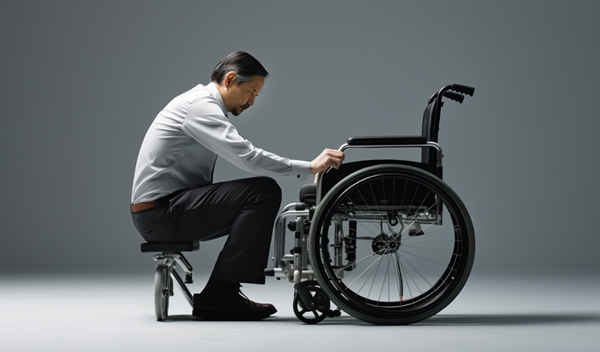
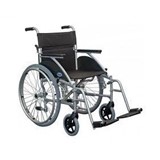
-160x160-state_article-rel-cat.jpg)
